动词时态和语态
- 格式:pdf
- 大小:136.95 KB
- 文档页数:6
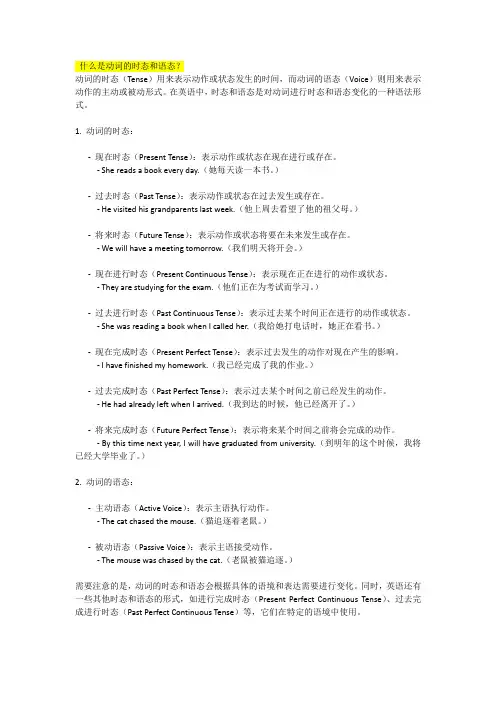
什么是动词的时态和语态?动词的时态(Tense)用来表示动作或状态发生的时间,而动词的语态(Voice)则用来表示动作的主动或被动形式。
在英语中,时态和语态是对动词进行时态和语态变化的一种语法形式。
1. 动词的时态:-现在时态(Present Tense):表示动作或状态在现在进行或存在。
- She reads a book every day.(她每天读一本书。
)-过去时态(Past Tense):表示动作或状态在过去发生或存在。
- He visited his grandparents last week.(他上周去看望了他的祖父母。
)-将来时态(Future Tense):表示动作或状态将要在未来发生或存在。
- We will have a meeting tomorrow.(我们明天将开会。
)-现在进行时态(Present Continuous Tense):表示现在正在进行的动作或状态。
- They are studying for the exam.(他们正在为考试而学习。
)-过去进行时态(Past Continuous Tense):表示过去某个时间正在进行的动作或状态。
- She was reading a book when I called her.(我给她打电话时,她正在看书。
)-现在完成时态(Present Perfect Tense):表示过去发生的动作对现在产生的影响。
- I have finished my homework.(我已经完成了我的作业。
)-过去完成时态(Past Perfect Tense):表示过去某个时间之前已经发生的动作。
- He had already left when I arrived.(我到达的时候,他已经离开了。
)-将来完成时态(Future Perfect Tense):表示将来某个时间之前将会完成的动作。
- By this time next year, I will have graduated from university.(到明年的这个时候,我将已经大学毕业了。
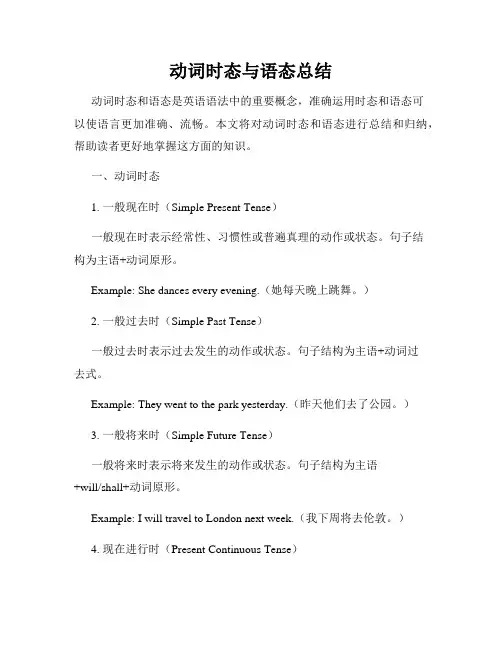
动词时态与语态总结动词时态和语态是英语语法中的重要概念,准确运用时态和语态可以使语言更加准确、流畅。
本文将对动词时态和语态进行总结和归纳,帮助读者更好地掌握这方面的知识。
一、动词时态1. 一般现在时(Simple Present Tense)一般现在时表示经常性、习惯性或普遍真理的动作或状态。
句子结构为主语+动词原形。
Example: She dances every evening.(她每天晚上跳舞。
)2. 一般过去时(Simple Past Tense)一般过去时表示过去发生的动作或状态。
句子结构为主语+动词过去式。
Example: They went to the park yesterday.(昨天他们去了公园。
)3. 一般将来时(Simple Future Tense)一般将来时表示将来发生的动作或状态。
句子结构为主语+will/shall+动词原形。
Example: I will travel to London next week.(我下周将去伦敦。
)4. 现在进行时(Present Continuous Tense)现在进行时表示现在正在进行的动作。
句子结构为主语+be动词+动词-ing形式。
Example: She is studying at the library.(她正在图书馆学习。
)5. 过去进行时(Past Continuous Tense)过去进行时表示过去某个时间正在进行的动作。
句子结构为主语+was/were+动词-ing形式。
Example: They were having dinner when the phone rang.(电话响时,他们正在吃晚饭。
)6. 将来进行时(Future Continuous Tense)将来进行时表示将来某个时间正在进行的动作。
句子结构为主语+will/shall+be+动词-ing形式。
Example: We will be waiting for you at the airport tomorrow.(明天我们将在机场等你。
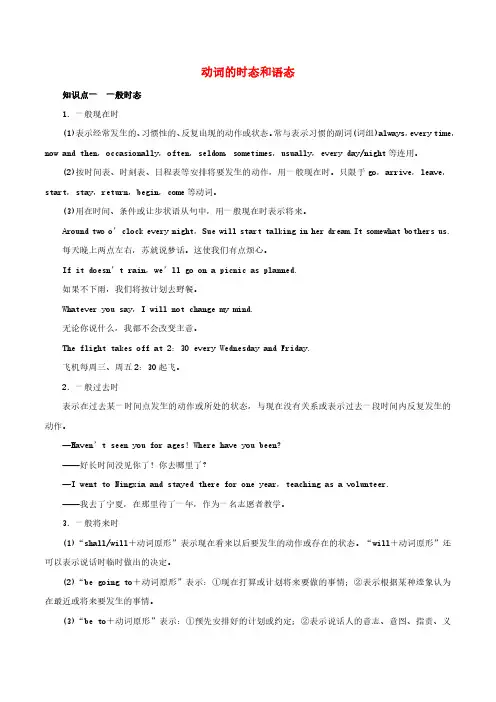
动词的时态和语态知识点一一般时态1.一般现在时(1)表示经常发生的、习惯性的、反复出现的动作或状态。
常与表示习惯的副词(词组)always,every time,now and then,occasionally,often,seldom,sometimes,usually,every day/night等连用。
(2)按时间表、时刻表、日程表等安排将要发生的动作,用一般现在时。
只限于go,arrive,leave,start,stay,return,begin,come等动词。
(3)用在时间、条件或让步状语从句中,用一般现在时表示将来。
Around two o’clock every night,Sue will start talking in her dream.It somewhat bothers us.每天晚上两点左右,苏就说梦话。
这使我们有点烦心。
If it doesn’t rain,we’ll go on a picnic as planned.如果不下雨,我们将按计划去野餐。
Whatever you say,I will not change my mind.无论你说什么,我都不会改变主意。
The flight takes off at2:30every Wednesday and Friday.飞机每周三、周五2:30起飞。
2.一般过去时表示在过去某一时间点发生的动作或所处的状态,与现在没有关系或表示过去一段时间内反复发生的动作。
—Haven’t seen you for ages!Where have you been?——好长时间没见你了!你去哪里了?—I went to Ningxia and stayed there for one year,teaching as a volunteer.——我去了宁夏,在那里待了一年,作为一名志愿者教学。
3.一般将来时(1)“shall/will+动词原形”表示现在看来以后要发生的动作或存在的状态。
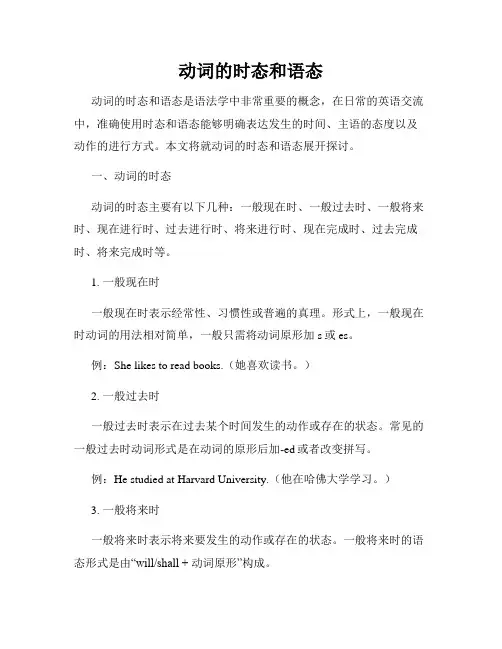
动词的时态和语态动词的时态和语态是语法学中非常重要的概念,在日常的英语交流中,准确使用时态和语态能够明确表达发生的时间、主语的态度以及动作的进行方式。
本文将就动词的时态和语态展开探讨。
一、动词的时态动词的时态主要有以下几种:一般现在时、一般过去时、一般将来时、现在进行时、过去进行时、将来进行时、现在完成时、过去完成时、将来完成时等。
1. 一般现在时一般现在时表示经常性、习惯性或普遍的真理。
形式上,一般现在时动词的用法相对简单,一般只需将动词原形加s或es。
例:She likes to read books.(她喜欢读书。
)2. 一般过去时一般过去时表示在过去某个时间发生的动作或存在的状态。
常见的一般过去时动词形式是在动词的原形后加-ed或者改变拼写。
例:He studied at Harvard University.(他在哈佛大学学习。
)3. 一般将来时一般将来时表示将来要发生的动作或存在的状态。
一般将来时的语态形式是由“will/shall + 动词原形”构成。
例:I will go to the park tomorrow.(明天我将去公园。
)4. 现在进行时现在进行时表示正在进行的动作。
现在进行时的时态形式是由“be 动词(am/is/are)+动词-ing形式”构成。
例:They are playing basketball now.(他们现在正在打篮球。
)5. 过去进行时过去进行时表示过去某个时间正在进行的动作。
过去进行时的时态形式是由“was/were + 动词-ing形式”构成。
例:He was studying at the library yesterday.(昨天他在图书馆学习。
)6. 将来进行时将来进行时表示将来某个时间正在进行的动作。
将来进行时的时态形式是由“will be + 动词-ing形式”构成。
例:They will be traveling to Europe next month.(他们下个月将要去欧洲旅行。
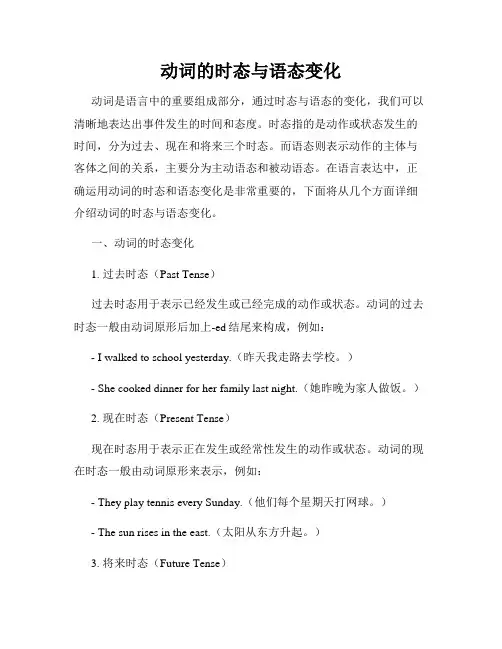
动词的时态与语态变化动词是语言中的重要组成部分,通过时态与语态的变化,我们可以清晰地表达出事件发生的时间和态度。
时态指的是动作或状态发生的时间,分为过去、现在和将来三个时态。
而语态则表示动作的主体与客体之间的关系,主要分为主动语态和被动语态。
在语言表达中,正确运用动词的时态和语态变化是非常重要的,下面将从几个方面详细介绍动词的时态与语态变化。
一、动词的时态变化1. 过去时态(Past Tense)过去时态用于表示已经发生或已经完成的动作或状态。
动词的过去时态一般由动词原形后加上-ed结尾来构成,例如:- I walked to school yesterday.(昨天我走路去学校。
)- She cooked dinner for her family last night.(她昨晚为家人做饭。
)2. 现在时态(Present Tense)现在时态用于表示正在发生或经常性发生的动作或状态。
动词的现在时态一般由动词原形来表示,例如:- They play tennis every Sunday.(他们每个星期天打网球。
)- The sun rises in the east.(太阳从东方升起。
)3. 将来时态(Future Tense)将来时态用于表示将要发生的动作或状态。
动词的将来时态一般由助动词will或shall加上动词原形构成,例如:- We will go on a trip next week.(下周我们将去旅行。
)- She shall study hard for the exam.(她将为考试努力学习。
)二、动词的语态变化1. 主动语态(Active Voice)主动语态表示主语是动作的执行者或实施者。
在主动语态中,主语在句子中承担着主要的语法成分,动词根据主语的人称和数的变化而变化。
例如:- They built a new house.(他们建了一座新房子。
)- She writes articles for a magazine.(她为一家杂志写文章。
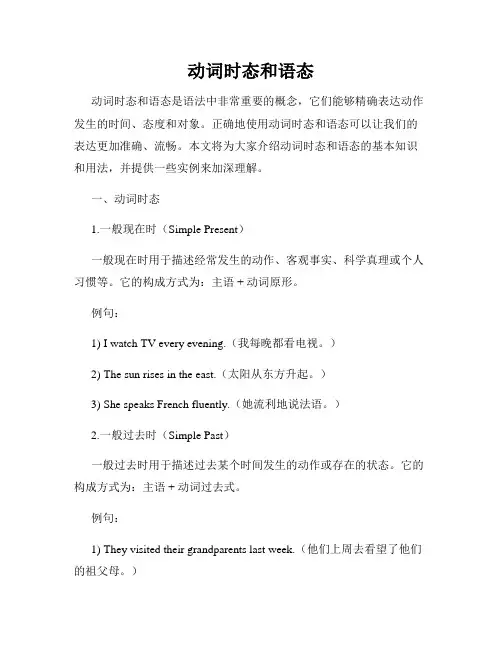
动词时态和语态动词时态和语态是语法中非常重要的概念,它们能够精确表达动作发生的时间、态度和对象。
正确地使用动词时态和语态可以让我们的表达更加准确、流畅。
本文将为大家介绍动词时态和语态的基本知识和用法,并提供一些实例来加深理解。
一、动词时态1.一般现在时(Simple Present)一般现在时用于描述经常发生的动作、客观事实、科学真理或个人习惯等。
它的构成方式为:主语 + 动词原形。
例句:1) I watch TV every evening.(我每晚都看电视。
)2) The sun rises in the east.(太阳从东方升起。
)3) She speaks French fluently.(她流利地说法语。
)2.一般过去时(Simple Past)一般过去时用于描述过去某个时间发生的动作或存在的状态。
它的构成方式为:主语 + 动词过去式。
例句:1) They visited their grandparents last week.(他们上周去看望了他们的祖父母。
)2) I lived in London for five years.(我在伦敦生活了五年。
)3) He didn't finish his homework yesterday.(他昨天没完成作业。
)3.一般将来时(Simple Future)一般将来时用于描述将要发生的动作或存在的状态。
它的构成方式为:主语 + will + 动词原形。
例句:1) I will call you later.(我过会儿会给你打电话。
)2) They will travel to Japan next month.(他们下个月会去日本旅行。
)3) She won't be here tomorrow.(她明天不会在这里。
)4.现在进行时(Present Continuous)现在进行时用于描述当前正在进行的动作。
它的构成方式为:主语+ am/is/are + 动词-ing。
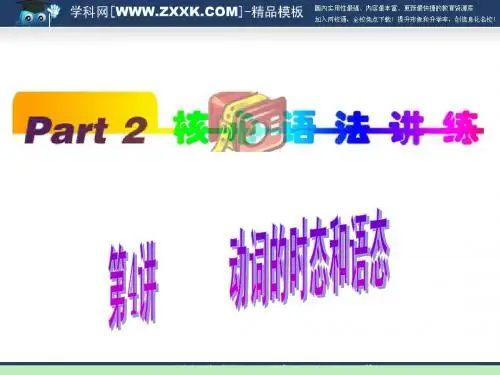
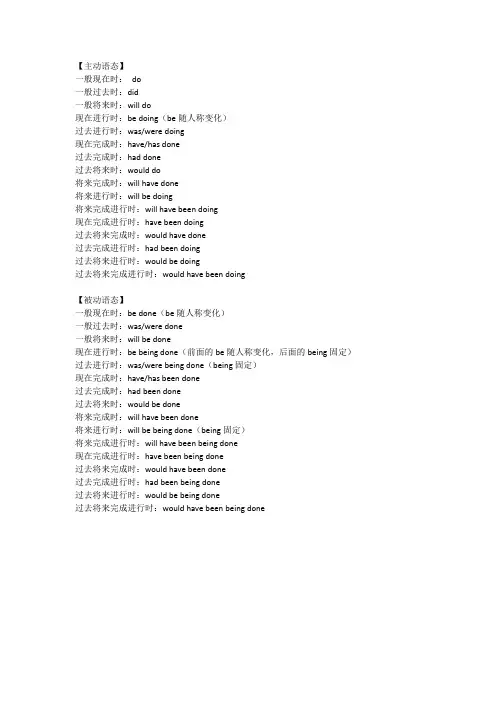
【主动语态】一般现在时:do一般过去时:did一般将来时:willdo现在进行时:be doing(be随人称变化)过去进行时:was/weredoing现在完成时:have/has done过去完成时:had done过去将来时:woulddo将来完成时:will have done将来进行时:will be doing将来完成进行时:will have been doing现在完成进行时:have been doing过去将来完成时:would have done过去完成进行时:had been doing过去将来进行时:would be doing过去将来完成进行时:would have been doing【被动语态】一般现在时:be done(be随人称变化)一般过去时:was/were done一般将来时:will be done现在进行时:be being done(前面的be随人称变化,后面的being固定)过去进行时:was/were being done(being固定)现在完成时:have/has been done过去完成时:had been done过去将来时:would be done将来完成时:will have been done将来进行时:will be being done(being固定)将来完成进行时:will have been being done现在完成进行时:have been being done过去将来完成时:would have been done过去完成进行时:had been being done过去将来进行时:would be being done过去将来完成进行时:would have been being done。
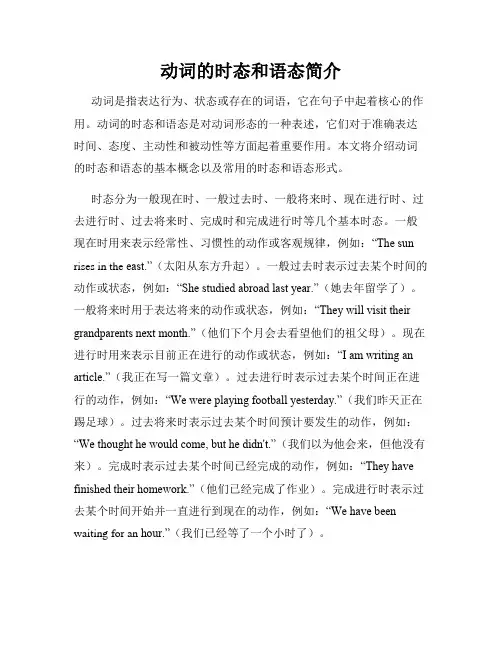
动词的时态和语态简介动词是指表达行为、状态或存在的词语,它在句子中起着核心的作用。
动词的时态和语态是对动词形态的一种表述,它们对于准确表达时间、态度、主动性和被动性等方面起着重要作用。
本文将介绍动词的时态和语态的基本概念以及常用的时态和语态形式。
时态分为一般现在时、一般过去时、一般将来时、现在进行时、过去进行时、过去将来时、完成时和完成进行时等几个基本时态。
一般现在时用来表示经常性、习惯性的动作或客观规律,例如:“The sun rises in the east.”(太阳从东方升起)。
一般过去时表示过去某个时间的动作或状态,例如:“She studied abroad last year.”(她去年留学了)。
一般将来时用于表达将来的动作或状态,例如:“They will visit their grandparents next month.”(他们下个月会去看望他们的祖父母)。
现在进行时用来表示目前正在进行的动作或状态,例如:“I am writing an article.”(我正在写一篇文章)。
过去进行时表示过去某个时间正在进行的动作,例如:“We were playing football yesterday.”(我们昨天正在踢足球)。
过去将来时表示过去某个时间预计要发生的动作,例如:“We thought he would come, but he didn't.”(我们以为他会来,但他没有来)。
完成时表示过去某个时间已经完成的动作,例如:“They have finished their homework.”(他们已经完成了作业)。
完成进行时表示过去某个时间开始并一直进行到现在的动作,例如:“We have been waiting for an hour.”(我们已经等了一个小时了)。
语态是指动词对于主语的态度和主动性或被动性的表达方式。
主动语态表示主语是动作的执行者,而被动语态则表示主语是动作的承受者。
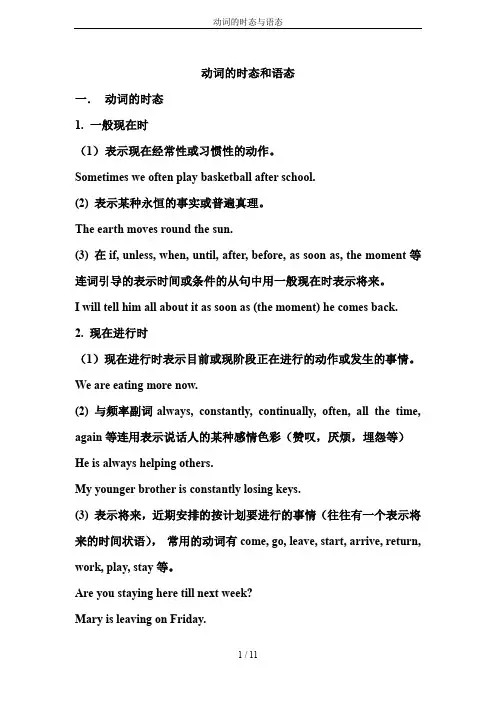
动词的时态和语态一.动词的时态1.一般现在时(1)表示现在经常性或习惯性的动作。
Sometimes we often play basketball after school.(2) 表示某种永恒的事实或普遍真理。
The earth moves round the sun.(3) 在if, unless, when, until, after, before, as soon as, the moment等连词引导的表示时间或条件的从句中用一般现在时表示将来。
I will tell him all about it as soon as (the moment) he comes back.2. 现在进行时(1)现在进行时表示目前或现阶段正在进行的动作或发生的事情。
We are eating more now.(2) 与频率副词always, constantly, continually, often, all the time, again等连用表示说话人的某种感情色彩(赞叹,厌烦,埋怨等)He is always helping others.My younger brother is constantly losing keys.(3) 表示将来,近期安排的按计划要进行的事情(往往有一个表示将来的时间状语),常用的动词有come, go, leave, start, arrive, return, work, play, stay等。
Are you staying here till next week?Mary is leaving on Friday.3.现在完成时现在完成时表示动作发生在过去,但强调与现在情况仍有联系,其结果或影响仍存在。
(1)for+时间段,since+时间点They have lived in Beijing for five years.(2) 常见的时间状语:lately, recently, just, already, yet, up to now,till now, so far, these days. in the past few------, over the past few----, throughout centuries, throughout histories.So far(up till now) I have only read half the story.I haven’t seen much of him recently.(these days)(3) 表示“第几次做某事”It\This\That is thefirst\second\third---time that 或在It\This is the best \worst\most interesting +名词+that后面跟现在完成时。
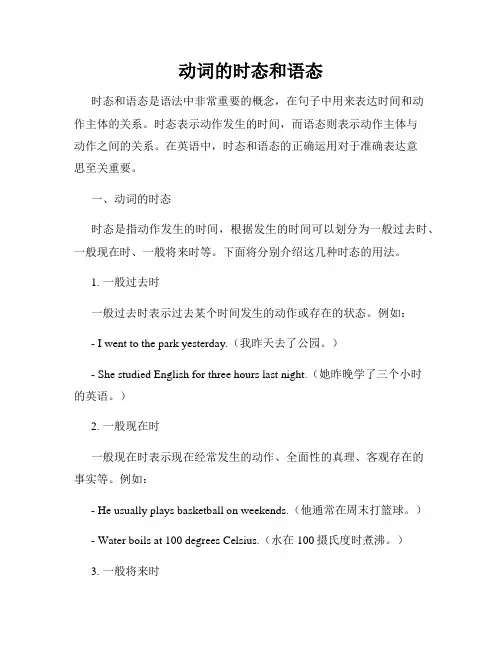
动词的时态和语态时态和语态是语法中非常重要的概念,在句子中用来表达时间和动作主体的关系。
时态表示动作发生的时间,而语态则表示动作主体与动作之间的关系。
在英语中,时态和语态的正确运用对于准确表达意思至关重要。
一、动词的时态时态是指动作发生的时间,根据发生的时间可以划分为一般过去时、一般现在时、一般将来时等。
下面将分别介绍这几种时态的用法。
1. 一般过去时一般过去时表示过去某个时间发生的动作或存在的状态。
例如:- I went to the park yesterday.(我昨天去了公园。
)- She studied English for three hours last night.(她昨晚学了三个小时的英语。
)2. 一般现在时一般现在时表示现在经常发生的动作、全面性的真理、客观存在的事实等。
例如:- He usually plays basketball on weekends.(他通常在周末打篮球。
)- Water boils at 100 degrees Celsius.(水在100摄氏度时煮沸。
)3. 一般将来时一般将来时表示将来某个时间要发生的动作或存在的状态。
例如:- I will visit my grandparents next month.(我下个月会去看望我的祖父母。
)- They are going to have a party tomorrow.(他们明天要开派对。
)二、动词的语态语态是指动作主体与动作之间的关系,根据动作主体的不同可以分为主动语态和被动语态。
1. 主动语态主动语态表示主语是动作的执行者。
例如:- She wrote an article for the newspaper.(她为报纸写了一篇文章。
)- They are building a new house.(他们正在建一所新房子。
)2. 被动语态被动语态表示主语是动作的承受者。
例如:- The book was written by Mark Twain.(这本书是马克·吐温写的。
专题七动词的时态和语态考点精讲1.过去进行时过去进行时主要用来表达过去某个时间正在进行的行为或正存在的状态。
(1)表示过去某一时间正在进行的动作,常与表示过去时间的状语then, at that moment, at that time, this time yesterday等连用。
What were you doing this time last night?昨天晚上这个时候你在做什么?He was writing a book last year, but I don't know if he has finished it.他去年在写一本书,我不知他现在是否已经完成。
(2)表示从过去某一时间的角度看将要发生的动作。
常表示过去“渐渐,快要、越来越、马上”,常见的此类动词有come, go, start, begin, leave, arrive, get, become, turn等非持续性动词。
偶尔有些持续性动词,如:do, stay, take等常表示过去“将要”。
We were running out of the gas.我们的汽油快用光了。
She told me that she was leaving for Italy the next day.她告诉我第二天就出发到意大利。
(3)过去进行时与always, forever, constantly等时间状语连用时,表示说话者过去对某一事情的厌烦,不耐烦,褒扬等特殊情感。
She was always ringing me up when l was in London.我在伦敦时她总不停地给我打电话。
(表示厌烦)Joy was always complaining about her busy life.乔伊总不停地抱怨自己工作繁忙。
(表示不耐烦)She was always helping others when she lived here.她住在这里时总是乐于帮助别人。
动词的时态和语态英语动词时态变化从时间上可划分为“现在时”,“过去时”,“将来时”和“过去将来时”四大类,每类又包括“一般式”、“进行式”、“完成式”和“完成进行式”四式,共十六种时态形式。
其中常用的有十种:一般现在时、一般过去时、一般将来时、过去将来时、现在进行时、过去进行时、现在完成时、过去完成时、将来完成时、现在完成进行时等十种。
⒈一般现在时:构成:主语+ 动词原形或第三人称单数形式用法:* 经常性或习惯性的动作,常与usually, always, sometimes, every day, frequently等一起使用。
We raise ducks as a sideline. 我们以养鸭为副业。
I cycle to work every day.我每天骑车去上班。
Mike always takes a job in his holidays.迈克总是在假期找个工作。
It often rains in this area.这个地区经常下雨。
* 现在存在的状态或具有的特征The Arabs are famous for their horses and camels.阿拉伯人以马和骆驼而闻名于世。
China is a great socialist country.中国是一个伟大的社会主义国家。
* 客观规律、正确事实或科学真理、格言以及其他不受时间限制的客观存在Light travels much faster than sound.光比声音传播快得多。
Most matter has three states.大多数物质有三种形态。
* 表示安排或计划要做的动作(句中常有表示未来时间的状语),主要用于begin, come, leave, go, arrive, start, stop, open, close等瞬间动词。
The plane takes off at seven o’clock this evening.飞机定于今晚七点起飞。
动词的时态与语态一、动词的分类和形式:动词是表示动作和状态的词。
动词有时态、语态和语气3种形式的变化。
1、动词按其能否独立作谓语而分为:"谓语动词"和"非谓语动词"两种2、动词的4种基本形式:动词原形、过去式、过去分词和现在分词。
3、动词按其构成动词词组作用分为:实义动词、连系动词、情态动词和助动词。
1)实义动词分为及物动词和不及物动词。
还可分为持续性动词和瞬间动词;2)连系动词有两种:一种表特征或状态,另一种表状态变化过程。
4、五种不同的短语动词:1)"动词+介词";2)"动词+副词";3)"动词+副词+介词";4)"动词+名词(或代词)+介词";5)"be+形容词(包括相当于形容词的过去分词+介词"。
二、动词的时态:1、一般现在时的用法:1)表示现在的习惯,经常发生的动作或存在的状态。
2)表示主语的特征、性格和能力。
3)表示客观事实或真理。
4)表示按照计划安排好的将来行为。
(只限于是go,come, leave, start, stop, be等开始或移动意义的词。
)He usually goes to work at 7 o’clock ever y morning.She has a brother who lives in New York.The earth goes around the sun.Guangzhou is situated in the south of China.2、一般过去时的用法:1)表示过去的动作或状态。
2)叙述过去连续发生的事情。
3)表示过去一段时间内经常发生的动作。
常跟明确的过去时间连用,如:yesterday; last week; in 1945, at that time; once; during the war; before; a few days ago; when3、一般将来时的用法:1)表示将来的动作或状态。
动词的时态1. 动词的时态主要有:一般现在时、现在进行时、现在完成时、现在完成进行时、一般过去时、过去进行时、过去完成时、一般过去将来时、一般将来时、将来进行时和将来完成时等。
2. 一般将来时的表达方式:(1)一般将来时表示未来的动作或状态,常与表示将来的时间状语,如:tomorrow, next day, soon, in a month, in the future, next Sunday等连用。
有时句中无时间状语,时间关系由上下文暗示;(2)will do还表示临时的决定;(3)在if, unless, before, after, until等引导的条件或时间状语从句中,从句用一般现在时代替一般将来时,而主句用一般将来时;(4) “be going to+动词原形”表示打算、计划、决定要做的事或有迹象表明即将发生的动作或状态;(5) “be+V-ing形式”表示按计划、安排即将发生的动作,这一结构常用于以下动词,如:come, go, leave, arrive, return, fly, meet, see, do, have, get等;(6) “be about to+动词原形”表示打算或安排即将发生的动作。
它一般不与表示时间的副词或其他时间状语连用;(7) “be to+动词原形”表示按计划、安排即将发生的动作;(8) 一般现在时表示按时刻表或根据规定将要发生的动作,这一结构常用于表示位移的动词,如:come, go, leave, start, begin, take off, set off等。
动词的语态1. 一般现在时的被动语态:is/am/are+V-ed。
例如:English is widely spoken all over the world.2. 一般过去时的被动语态:was/were+V-ed。
例如:The underground was built five years ago.3. 一般将来时的被动语态:①will/shall be+V-ed。
动词时态和语态(2)一、时态的呼应:在复合句,从句(主要是宾语从句)中的时态,常受主句谓语动词的影响,这就叫做时态的呼应,时态的呼应一般有如下的情况。
1、如果主句的谓语动词为现在时态,其从句中的谓语动词应该用什么时态就用什么时态,如:She knows you have been in Beijing for five rears.2、如果主句中的谓语动词为过去时态,从句中的谓语动词就要用过去时态,但要注意到下列情况:(1)如果从句中的谓语动词所表示的动作与主句中的谓语动词所表示的动作同时发生,从句中须用一般过去时或过去进行时,如:She said she was busy then. (2)如果从句中的谓语动词所表示的动作发生在主句谓语动词所表示的动作之前,从句中须用过去完成时,如:I didn’t know that she had been to London twice. (3)如果从句中的谓语动词所表示的动作发生在主句谓语动词所表示的动作之后,从句须用过去将来时,如:They didn’t know when they would have a rest. (4)如果从句中说明的是一种普遍真理现象,虽然主句的谓语动词为过去时态从句中仍要用一般现在时,如:When I was a little child, my father told me that the earth is round. (5)如果从句中有表示具体过去时间的状语,虽然其谓语动词所表示的动作发生在主句谓语动词所表示的动作之前,从句仍用一般过去时,但如果该状语表示的时间不具体,则从句仍要用过去完成时,如:Tome said he was born in 1975.二、被动语态:英语动词的语态有两种:主动语态和被动语态。
主动语态表示主语是动作的执行者,被动语态表示主语是动作的承受者,在被动语态的句子中,动作的执行者,一般由介词by引起的短语来表示,如:We often help them. (主动)我们常帮助他们。
They are often helped by us.(被动)他们常被我们帮助。
1、被动语态各时态的形式是由助动词be的各时态的形式加及物动词的过去分词构成。
2、被动语态八种时态的用法例句:被动语态常用的八种时态的基本用法和主动语态各时态的基本用法相同,只是句中的主语不是动作的执行者,而是动作的承受者,如:(1)一般现在时:Now English is taught in all middle schools in our country. (2)一般过去时:The Great hall of the People was built in 1959. (3)一般将来时: When will the work be finished? (4)过去将来时:He told us that the work would be finished the next day. (5)现在进行时:Your tractor is being repaired now.(6)过去进行时:The child was being examined by the doctor when they came in. (7)现在完成时:The work hasn’t been finished yet. (8)过去完成:The new plan had been carried out before the second experiment began.3、在下列情况下,一般使用被动语态:(1)当不知道动作执行者是谁或没有必要提到动作执行者时,如:Paper was first made in China.(2)当强调或突出动作承受者的作用时,如:The new machine was invented by a 20-year-old young worker.4、由主动语态转换为被动语态的几种句型:(1)将一个句子由主动语态转换为被动语态时,可按下列步骤进行:①先将主动结构的宾语改为被动结构的主语;②再将主动语态动词改为被动语态动词;③最后在被动语态之后加介词by,并将主动结构的主语放在by之后(经常被省略),构成介词短语;④由主动语态动词改为被动语态动词时,要注意被动语态动词中助动词be的各种形式变化,因为被动语态动词的不同人称和数是由助动词be不同的形式来表示的,如:Trees are planted every spring.(2)如果主动语态动词后又有直接宾语,又有间接宾语,一般是将间接宾语改为被动语态句中的主语,将直接宾语保留在原处。
如将直接宾语改为被动语态句中的主语,将间接宾语保留在原处时,一般要在间接宾语前加介词to或 for,如:Grandma told me an interesting story last night.→Iwas told an interesting story last night./ An interesting story was told to me last night. (3)主动语态中的宾语加带有宾语补足语时,改为被动语态时,就将宾语改为主语,将宾补保留在原处,而成为被动语态句中主语的补足语了。
宾补可以有下列几种情况:①宾补为动词不定式,如:They asked her to sing a song. →She was asked to sing a song. 在动词make, see, hear, watch, notice等之后,不定式的to在主动语态里可要省略,而被动语态里不能省,如:Tom was seen to come out of the lab.②宾补为分词,如:They heard them singing at the time.→They were heard singing at that time.③宾补为形容词、副词、名词或介词短语,如:She kept me busy all the morning. →I was kept busy all the morning.(4)如果主动语态中的谓语动词为短语动词,改为被动语态时,要注意不要遗漏短语中的介词或副词,以保持短语动词的完整性,如:She always takes good care of the children. →The children are always taken good care of. (5)含有情态动词的动词改为被动语态时是将情态动词后面的动词原形改为被动语态,因其前有情态动词,所以构成被动语态的助动词be就要使用原形,如:They must finish the work before Friday. →The work must be finished before Friday.(6)be going to, be to, used to, have to和had better等结构,其作用相当于情态动词或助动词,在改为被动语态时,只需将后面的动词原形改为被动语态即可,如:The are not going to put off the football match. →The football match is not going to be put off.练习二、动词时态与语态(2)53. An exhibition of paintings ____ at the museum next week.A. are to be heldB. is to be heldC. are holdingD. will hold54. I'm sorry, sir. Your recorder isn't ready yet. It _____ in the factory.A. is being repairedB. is repairedC. has been repairedD. hasn't repaired55. Every possible means , but none prove successful.A. has triedB. has been triedC. is being triedD. tried56. _______ that they can pass the written exam this time.A. That is hopedB. It is hopedC. That hopesD. It hopes57. My little sister has broken my watch. ---- My watch _____ by my little sister.A. is brokenB. has brokenC. have been brokenD. has been broken58. He was cleaning his room when I entered the house.---- His room _____ by him when I entered the room.A. was being cleanedB. was cleanedC. was being cleaningD. has been cleaned59. I shall have Finished reading the novel by dinner time.---- This novel _____ reading (by me) by dinner time.A. will have finished .B. will has been finishedC. will have being finishedD. will have been finished60. You ought to keep these three rooms clean. ----These three rooms______ (by you).A. are oughted to keep cleanB. ought to kept cleanC. ought to be kept cleanD. ought to have been kept clean61. You are about to write a poem, aren't you? ---- A poem _____ (by you), _____ ?A. is about to be written, aren't youB. is about to be writing, isn’t itC. is about to be writing, aren't youD. is about to be written, isn’t it62. She had better leave a note to him. ---- A note _____ to him (by her).A. had better leftB. had be better leftC. had better be leftD. had better been left63. He doesn't do his homework every day. ---- His homework ______ by him every day.A. doesn't be doneB. aren't doneC. don't be doneD. isn’t done64. We must take care of our parents when they are old. ---- Our parents______ when they are old.A. must be taken careB. must be took carsC. must take care ofD. must be taken care of65. People look down upon him because he is a liar. ---- He _____ because he is a liar.A. is looked downB. is looked down uponC. looks down uponD. looks down66. Father will give me a dictionary on my birthday.---- A dictionary ______ me by Father on my birthday.A. shall be given toB. will giveC. shall give toD. will be giving to67. We elected her leader. ---- She by us.A. is elected leaderB. was leader electedC. was elected leaderD. leader was elected68. ---- People who live along this road receive their mail in these boxes.---- Why are all of the______?A. grey painted mailboxesB. mailboxes grey paintedC. mailboxes painted greyD. painted grey mailboxes69. I saw him enter the room. ---- He ______ the room.A. is seen enterB. is seen to enterC. was seen to enterD. was seen enter70. The question asked by him is hard _____ .A. to answerB. to be answeredC. to be answeringD. for answer71. How sweet the music ______!A. sounds to beB. is soundedC. is sounded to beD. sounds72. In warm weather fruit and meat ______ long.A. don't keepB. cannot be keptC. are not keptD. are not keeping73. He received a telegram ___ "Mother Sick."A. writtenB. saidC. readingD. writing74. The classroom ______ 30 feet long.A. measuresB. is measuredC. hasD. has length75. Do you remember ______ ?A. how it is doneB. it how to be doneC. How is it done byD. how to do76. to have been rich.A. They sayB. It is saidC. He is saidD. That was said77. Mathematics is difficult ______.A. to learnB. for learningC. to be learnedD. of learning78. My hair is so long that I must go to a barber's shop and______.A. have to cut itB. have it cutC. get it to be cutD. to cut it79. The pencil ______ well.A. writesB. is writtenC. was writtenD. writing80. ---- I can't see the blackboard very well. ---- Perhaps you need ______.A. to examine your eyesB. to have your eyes examinedC. to have examined your eyesD. to be examined your eyes81. ---- Where is the coffee table? ---- Tom just had it ____ away.A. moveB. movingC. movedD. moves82. Good medicine ______ to the mouth.A. tastes bitterB. tastes bitterlyC. is tasted bitterD. is tasted bitterly83. Which girl won the prize? _____A. By which girl is the prize won?B. Which girl was the prize won?C. By which girl did she win the prize?D. By which girl was the prize won?84. --- Where did you get that handsome picture? ---- It was _____ by my father.A. given for usB. a gift to usC. given to usD. a gift for us85. A young hen is ______ a chicken.A. namedB. knownC. spelledD. called86. ---- How does Alma like her new work? ---- She ______ with the hour.A. can't satisfyB. isn't satisfiedC. doesn't satisfyD. hasn't satisfied87. ---- Why do you call your son Mouse? ---- He wants ______ by the name.A. to callB. to be calledC. to be callingD. being called88. His idea, though good, needs ______ out.A. being triedB. to tryC. triedD. to be tried89. The man living in the next door is known _____the police.A. withB. toC. byD. of90. Cotton is first made ______ thread and then it was woven ______ cloth.A. up of, up ofB. into, intoC. of, ofD. from, from91. ______ here last night.A. Something strange was happenedB. Strange something was happenedC. Something strange happenedD. Strange something happened92. ---- I'd like to buy that coat. ---- I'm sorry, _____.A. it was soldB. it's sellingC. it's been soldD. it had been sold93. Gunpowder was discovered in the twelfth century, but_____.A. man did not put it to use in war two hundred years literB. until two centuries more it was used in warC. not used in war until two hundred years laterD. in war did not use it two hundred years afterwards94. The five-year-old girl by her parents.A. is lookedB. has looked forC. is being looked forD. has been looked。